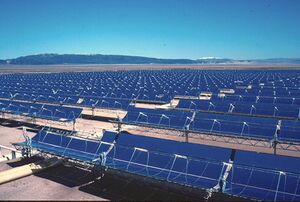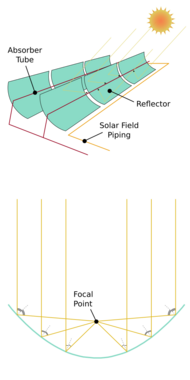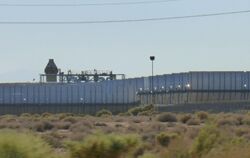Engineering:Solar Energy Generating Systems
| Solar Energy Generating Systems | |
|---|---|
 Part of the 354 MW SEGS solar complex in northern San Bernardino County, California. | |
| Lua error in Module:Mapframe at line 384: attempt to perform arithmetic on local 'lat_d' (a nil value). | |
| Country | United States |
| Location | Mojave Desert |
| Coordinates | [ ⚑ ] : 35°01′54″N 117°20′53″W / 35.0316°N 117.348°W |
| Status | Operational |
| Construction began | 1983 |
| Project commissioning | 1984 |
| Owner(s) | NextEra Energy Resources |
| Solar farm | |
| Type | CSP |
| CSP technology | Parabolic trough |
| Collectors | 936,384 |
| Site resource | 2,725 kWh/m2/yr |
| Site area | 1,600 acres (647.5 ha) |
| Power generation | |
| Nameplate capacity | 160 MW |
| Capacity factor | 19.2% |
| Annual net output | 539 GW·h (2015) |
Solar Energy Generating Systems (SEGS) is a concentrated solar power plant in California , United States. With the combined capacity from three separate locations at 354 megawatt (MW), it was once the world's second largest solar thermal energy generating facility, until the commissioning of the even larger Ivanpah facility in 2014. It consisted of nine solar power plants in California's Mojave Desert, where insolation is among the best available in the United States.
SEGS I–II (44 MW) were located at Daggett ( [ ⚑ ] 34°51′45″N 116°49′45″W / 34.8625°N 116.82917°W); they have been replaced with a solar photovoltaic farm.
SEGS III–VII (150 MW) were installed at Kramer Junction ( [ ⚑ ] 35°00′43″N 117°33′32″W / 35.01194°N 117.55889°W); all five SEGS have undergone demolition.[1][2][3]
SEGS VIII–IX (160 MW) are located at Harper Lake ( [ ⚑ ] 35°01′55″N 117°20′50″W / 35.03194°N 117.34722°W).[4] NextEra Energy Resources operates and partially owns the plants located at Kramer Junction. On January 26, 2018, the SEGS VIII and IX at Harper Lake were sold to renewable energy company Terra-Gen, LLC.
A tenth plant (SEGS X, 80 MW) had been in construction and SEGS XI and SEGS XII had been planned by Luz Industries, but the developer filed for bankruptcy in 1992, because it was unable to secure construction financing.[5] The site of SEGS X was later licensed for a solar photovoltaic farm, Lockhart Solar PV II.[6]
Most of the thermal facilities were retired by 2021,[7] and photovoltaics were built on the same sites.
Plants' scale and operations
Before retirement and replacement of SEGS I-VII with solar photovoltaics, the plants had a 354 MW net (394 MW gross) installed capacity. The nameplate capacity, which operating continuously, would dеliver the samе net power output, coming only from the solar source was around 75 MWe —, representing a 21% capacity factor. In addition, the turbines could be utilized at night by burning natural gas.
NextEra claimed in 2009 that the solar plants could power 232,500 homеs (during the day, at peak power) and displace 3,800 tons of pollution pеr year that would have been produced if the electricity had been providеd by fossil fuels, such as oil.[8]
The facilities had a total of 936,384 mirrors and cover more than 1,600 acres (647.5 ha). Lined up, the parabolic mirrors would have extended over 229 miles (369 km).
As an example of cost, in 2002, one of the 30 MW Kramer Junction sites required $90 million to construct, and its operation and maintenance cost was about $3 million per year (4.6 cents per kilowatt hour).[9] With a considered lifetime of 20 years, the operation, maintenance and investments interest and depreciation triples the price, to approximately 14 cents per kilowatt hour.[citation needed]
Principle of operation
The installation uses parabolic trough, solar thermal technology along with natural gas to generate electricity. About 90% of the electricity is produced by the sunlight.[citation needed] Natural gas is only used when the solar power is insufficient to meet the demand from Southern California Edison, the distributor of power in southern California.[10]
Mirrors
The parabolic mirrors are shaped like quarter-pipes. The sun shines on glass panels, which are 94% reflective, unlike a typical mirror, which is only 70% reflective. The mirrors automatically track the sun throughout the day. The greatest source of mirror breakage is wind, with 3,000 mirrors typically replaced each year. Operators can turn the mirrors to protect them during intense wind storms. An automated washing mechanism is used to periodically clean the parabolic reflective panels. The term "field area" is assessed as the actual collector area.
Heat transfer
The sunlight bounces off the mirrors and is directed to a central tube filled with synthetic oil, which heats to over 400 °C (750 °F). The reflected light focused at the central tube is 71 to 80 times more intense than the ordinary sunlight. The synthetic oil transfers its heat to water, which boils and drives the Rankine cycle steam turbine,[11] thereby generating electricity. Synthetic oil is used to carry the heat (instead of water) to keep the pressure within manageable parameters.
Individual locations
The SEGS power plants were built by Luz Industries,[11]Cite error: Closing </ref> missing for <ref> tag KJC Operating Company,[12] IEEE,[13] NREL[14][15]
|}
| Gross solar production of electricity (MWh) | ||||||||||||||
|---|---|---|---|---|---|---|---|---|---|---|---|---|---|---|
| Plant | 1991 | 1992 | 1993 | 1994 | 1995 | 1996 | 1997 | 1998 | 1999 | 2000 | 2001 | 2002 | average 1998–2002 | Total |
| SEGS I | 20,252 | 17,938 | 20,368 | 20,194 | 19,800 | 19,879 | 19,228 | 18,686 | 11,250 | 17,235 | 17,947 | 17,402 | 16,500 | 348,950 |
| SEGS II | 35,168 | 32,481 | 36,882 | 36,566 | 35,853 | 35,995 | 34,817 | 33,836 | 33,408 | 31,207 | 32,497 | 31,511 | 32,500 | 571,696 |
| SEGS III | 60,134 | 48,702 | 58,248 | 56,892 | 56,663 | 64,170 | 64,677 | 70,598 | 70,689 | 65,994 | 69,369 | 66,125 | 68,555 | 995,686 |
| SEGS IV | 64,600 | 51,007 | 58,935 | 57,795 | 54,929 | 61,970 | 64,503 | 71,635 | 71,142 | 63,457 | 64,842 | 70,313 | 68,278 | 1,017,283 |
| SEGS V | 59,009 | 55,383 | 67,685 | 66,255 | 63,757 | 71,439 | 75,936 | 75,229 | 70,293 | 73,810 | 71,826 | 73,235 | 72,879 | 1,014,444 |
| SEGS VI | 64,155 | 47,087 | 55,724 | 56,908 | 63,650 | 71,409 | 70,019 | 67,358 | 71,066 | 68,543 | 67,339 | 64,483 | 67,758 | 878,476 |
| SEGS VII | 58,373 | 46,940 | 54,110 | 53,251 | 61,220 | 70,138 | 69,186 | 67,651 | 66,258 | 64,195 | 64,210 | 62,196 | 65,048 | 834,986 |
| SEGS VIII | 102,464 | 109,361 | 130,999 | 134,578 | 133,843 | 139,174 | 136,410 | 137,905 | 135,233 | 140,079 | 137,754 | 138,977 | 137,990 | 1,691,773 |
| SEGS IX | 144,805 | 129,558 | 130,847 | 137,915 | 138,959 | 141,916 | 139,697 | 119,732 | 107,513 | 128,315 | 132,051 | 137,570 | 125,036 | 1,594,852 |
| Total | 608,960 | 538,458 | 613,798 | 620,358 | 628,674 | 676,091 | 674,473 | 662,631 | 636,851 | 652,835 | 657,834 | 662,542 | 654,539 | 8,967,123 |
| Sources: Solargenix Energy,[16] KJC Operating Company,[12] IEEE,[13] NREL[14][15] | ||||||||||||||
| Net solar production of electricity (MWh) | ||||||||||||||
|---|---|---|---|---|---|---|---|---|---|---|---|---|---|---|
| Plant | 2003 | 2004 | 2005 | 2006 | 2007 | 2008 | 2009 | 2010 | 2011 | 2012 | 2013 | 2014 | average 2003–2014 | Total |
| SEGS I | 6,913 | 8,421 | 6,336 | 5,559 | 0 | 10,705 | 9,033 | 10,648 | 11,164 | 11,666 | 9,403 | 8,583 | 8,203 | 98,431 |
| SEGS II | 11,142 | 14,582 | 13,375 | 7,547 | 5,445 | 28,040 | 18,635 | 22,829 | 26,198 | 25,126 | 23,173 | 7,611 | 16,975 | 203,703 |
| SEGS III | 59,027 | 64,413 | 56,680 | 51,721 | 59,480 | 69,012 | 62,971 | 60,029 | 61,350 | 56,877 | 56,824 | 54,407 | 59,399 | 712,791 |
| SEGS IV | 58,100 | 62,006 | 56,349 | 52,439 | 59,799 | 69,338 | 63,563 | 63,084 | 57,684 | 62,414 | 58,317 | 54,321 | 59,785 | 717,414 |
| SEGS V | 61,921 | 67,717 | 62,309 | 53,471 | 59,547 | 69,316 | 59,820 | 54,328 | 60,451 | 62,877 | 57,758 | 56,354 | 60,489 | 725,869 |
| SEGS VI | 50,504 | 53,618 | 51,827 | 45,076 | 65,832 | 67,156 | 62,750 | 63,576 | 59,327 | 56,082 | 52,539 | 50,547 | 56,570 | 678,834 |
| SEGS VII | 49,154 | 50,479 | 46,628 | 42,050 | 58,307 | 65,185 | 58,950 | 58,836 | 57,378 | 54,147 | 48,183 | 46,762 | 53,005 | 636,059 |
| SEGS VIII | 119,357 | 124,089 | 120,282 | 117,451 | 122,676 | 135,492 | 131,474 | 155,933 | 152,463 | 145,247 | 141,356 | 145,525 | 134,279 | 1,611,345 |
| SEGS IX | 115,541 | 123,605 | 120,915 | 117,310 | 122,699 | 150,362 | 139,756 | 163,899 | 160,506 | 164,203 | 154,082 | 147,883 | 140,063 | 1,680,761 |
| Total | 531,659 | 568,930 | 534,701 | 492,624 | 553,785 | 664,606 | 606,952 | 653,162 | 646,521 | 638,639 | 601,635 | 571,993 | 588,767 | 7,065,207 |
| Net solar production of electricity (MWh) | |||||||||
|---|---|---|---|---|---|---|---|---|---|
| Plant | 2015 | 2016 | 2017 | 2018 | 2019 | 2020 | 2021 | Total | Total 1985–2021 |
| SEGS I[17] | 12,562 | dec. | (PV) | (PV) | (PV) | (PV) | (PV) | 12,562 | 459,943 |
| SEGS II[18] | dec. | dec. | (PV) | (PV) | (PV) | (PV) | (PV) | 0 | 775,399 |
| SEGS III[19] | 52,073 | 46,582 | 44,115 | 43,849 | 38,242 | 0 | dec. | 224,861 | 1,933,518 |
| SEGS IV[20] | 53,117 | 49,034 | 43,182 | 44,406 | 41,865 | 0 | dec. | 231,604 | 1,969,301 |
| SEGS V[21] | 52,646 | 50,142 | 43,934 | 47,383 | 41,424 | 0 | dec. | 235,529 | 1,975,842 |
| SEGS VI[22] | 46,937 | 40,923 | 36,380 | 34,262 | 0 | 0 | dec. | 158,502 | 1,715,812 |
| SEGS VII[23] | 37,771 | 30,480 | 32,601 | 27,956 | 0 | 0 | dec. | 128,808 | 1,599,852 |
| SEGS VIII[24] | 138,149 | 140,849 | 123,451 | 132,871 | 120,530 | 114,557 | 81,699 | 852,106 | 4,189,538 |
| SEGS IX[25] | 145,863 | 142,867 | 131,268 | 137,564 | 124,375 | 122,045 | 116,013 | 919,995 | 4,161,294 |
| Total | 539,118 | 500,877 | 454,931 | 468,291 | 366,254 | 236,602 | 197,712 | 2,754,405 | 18,780,499 |
| Starting 2017, SEGS I was replaced by PV system Sunray 2, and SEGS II by PV system Sunray 3 | |||||||||
Harper Lake
Until Ivanpah Solar Power Facility was commissioned in 2014, SEGS VIII and SEGS IX, located at [ ⚑ ] 35°01′55″N 117°20′50″W / 35.031815°N 117.347270°W were the largest solar thermal power plants individually and collectively in the world.[26] They were the last, the largest, and the most advanced of the nine plants at SEGS, designed to take advantage of the economies of scale. Construction of the tenth plant in the same locality was halted because of the bankruptcy of Luz Industries. Construction of the approved eleventh and twelfth plants never started. Each of the three planned plants would have had 80 MW of installed capacity.[27] Abengoa Solar recently constructed the 280MW Mojave Solar Project (MSP) adjacent to the SEGS VIII and SEGS IX plants.[28] The MSP also uses concentrating solar thermal trough technology.
Starting in February 2020, SEGS VIII no longer burned natural gas. The last production month was October 2021. SEGS IX stopped burning natural gas starting October 2020, except for January 2021.
Kramer Junction
This location ( [ ⚑ ] 35°00′48″N 117°33′38″W / 35.013218°N 117.560531°W) receives an average of 340 days of sunshine per year, which makes it an ideal place for solar power generation. The average direct normal radiation (DNR) is 7.44 kWh/m2/day (310 W/m2),[12] one of the best in the nation[citation needed]. This was the location of SEGS II - VII, which were retired in 2019. As of 2021, they were going to be replaced with a new solar photovoltaic array called Resurgence I.[2][3]
Daggett
SEGS I and II were located at [ ⚑ ] 34°51′47″N 116°49′37″W / 34.8631°N 116.827°W and owned by Cogentrix Energy (Carlyle Group).[29] SEGS II was shut down in 2014 and was replaced by Sunray 3 (EIA plant code 10438), a 13,8 MW photovoltaic system. SEGS I was shut down one year later and replaced by 20 MW PV system Sunray 2 (EIA plant code 10437).[30][31] Sunray 2 and Sunray 3 started production in 2017 as per EIA data.
Accidents and incidents
In February 1999, a 900,000-US-gallon (3,400 m3) mineral oil storage tank exploded at the SEGS I (Daggett) solar power plant, sending flames and smoke into the sky. Authorities were trying to keep flames away from two adjacent containers that held sulfuric acid and sodium hydroxide. The immediate area of 0.5 square miles (1.3 km2) was evacuated.[32]
See also
- List of concentrating solar thermal power companies
- List of photovoltaic power stations
- List of solar thermal power stations
- Renewable energy in the United States
- Renewable portfolio standard
- Solar power
- Solar power plants in the Mojave Desert
- List of largest power stations in the world
- Solana Generating Station
References
- ↑ "SEGS III – VII - Kramer Junction" (in en). https://www.energy.ca.gov/powerplant/solar-thermal/segs-iii-vii-kramer-junction.
- ↑ 2.0 2.1 "Valley Clean Energy Makes Major Solar, Storage Power Deal". https://cal-cca.org/valley-clean-energy-makes-major-solarstorage-power-deal/.
- ↑ 3.0 3.1 "Resurgence Solar I & II Land Use Services Department Planning Commission Staff Report". http://www.sbcounty.gov/uploads/lus/pc/PROJ-2021-00019_Staff_Report_FINAL.pdf.
- ↑ The Energy Blog: About Parabolic Trough Solar
- ↑ "Large Solar Energy Projects". California Energy Commission. http://www.energy.ca.gov/sitingcases/solar/.
- ↑ ""2021-07-14 Lockhart Solar PV II NOP"". http://www.sbcounty.gov/uploads/LUS/Desert/2021-07-14_Lockhart%20Solar%20PV%20II_NOP.pdf.
- ↑ Cheah, Cindy (21 September 2021). "World's longest-operating solar thermal facility is retiring most of its capacity - Today in Energy - U.S. Energy Information Administration (EIA)". https://www.eia.gov/todayinenergy/detail.php?id=49616.
- ↑ "Solar Electric Generating System". http://www.nexteraenergyresources.com/content/where/portfolio/pdf/segs.pdf.
- ↑ "Reducing the Cost of Energy from Parabolic Trough Solar Power Plants", NREL, 2003
- ↑ Penn, Ivan (22 June 2017). "California invested heavily in solar power. Now there's so much that other states are sometimes paid to take it" (in en). http://www.latimes.com/projects/la-fi-electricity-solar/.
- ↑ 11.0 11.1 "Solar thermal power generation". Solel Solar Systems Ltd. http://www.solel.com/products/pgeneration/ls2/.
- ↑ 12.0 12.1 12.2 Frier, Scott (1999). An overview of the Kramer Junction SEGS recent performance. ed. Parabolic Trough Workshop. Ontario, California: KJC Operating Company. http://www.nrel.gov/csp/troughnet/pdfs/1999_kjc.pdf.
- ↑ 13.0 13.1 Kearney, D. (August 1989). "Solar Electric Generating Stations (SEGS)". IEEE Power Engineering Review (IEEE) 9 (8): 4–8. doi:10.1109/MPER.1989.4310850.
- ↑ 14.0 14.1 Price, Hank (2002). Parabolic trough technology overview. ed. Trough Technology - Algeria. NREL. p. 9. http://www.ornl.gov/sci/engineering_science_technology/world/renewable/Trough%20Technology%20-%20Algeria2.pdf.
- ↑ 15.0 15.1 Solar Electric Generating Station IX. NREL
- ↑ Cite error: Invalid
<ref>tag; no text was provided for refs namedCohen 2006 10 - ↑ EIA Electricity Data Browser - SEGS I
- ↑ EIA Electricity Data Browser - SEGS II
- ↑ EIA Electricity Data Browser - SEGS III
- ↑ EIA Electricity Data Browser - SEGS IV
- ↑ EIA Electricity Data Browser - SEGS V
- ↑ EIA Electricity Data Browser - SEGS VI
- ↑ EIA Electricity Data Browser - SEGS VII
- ↑ EIA Electricity Data Browser - SEGS VIII
- ↑ EIA Electricity Data Browser - SEGS IX
- ↑ Jones, J. (2000), "Solar Trough Power Plants", National Renewable Energy Laboratory. Retrieved 2010-01-04.
- ↑ "California Energy Commission - Large Solar Energy Projects". http://www.energy.ca.gov/siting/solar/index.html.
- ↑ Abengoa Solar - The Mojave Solar Project
- ↑ SUNRAY/SEGS
- ↑ California Solar Energy Statistics & Data
- ↑ Permit approved for solar facility
- ↑ Storage Tank at Solar Power Plant in Desert Explodes; Immediate Area Is Evacuated
 |



